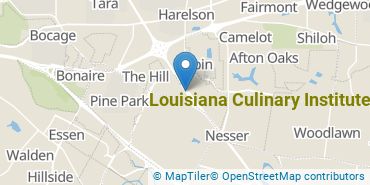Louisiana Culinary Institute Trade Programs
Located in Baton Rouge, Louisiana, Louisiana Culinary Institute is a private for-profit institution. The suburban atmosphere of Baton Rouge makes it a great place for students who want the amenities of city life without actually living in the middle of a constant hustle and bustle.
Featured schools near , edit
Where Is Louisiana Culinary Institute?

Contact details for Louisiana Culinary Institute are given below.
| Contact Details | |
|---|---|
| Address: | 10550 Airline Hwy, Baton Rouge, LA 70816 |
| Phone: | 225-769-8820 |
| Website: | www.lci.edu |
Can I Afford Louisiana Culinary Institute?
| In State | Out of State | |
|---|---|---|
| Tuition | $15,500 | $15,500 |
| Fees | $75 | $75 |
| Books and Supplies | $3,000 | $3,000 |
Student Loan Debt
While almost two-thirds of students nationwide take out loans to pay for college, the percentage may be quite different for the school you plan on attending. At Louisiana Culinary Institute, approximately 81% of students took out student loans averaging $11,759 a year. That adds up to $47,036 over four years for those students.
Louisiana Culinary Institute Undergraduate Student Diversity
Gender Diversity
Of the 114 full-time undergraduates at Louisiana Culinary Institute, 49% are male and 51% are female.

Racial-Ethnic Diversity
The racial-ethnic breakdown of Louisiana Culinary Institute students is as follows.

| Race/Ethnicity | Number of Grads |
|---|---|
| Asian | 0 |
| Black or African American | 51 |
| Hispanic or Latino | 5 |
| White | 58 |
| International Students | 0 |
| Other Races/Ethnicities | 0 |
Louisiana Culinary Institute Trade School Concentrations
The table below shows the number of awards for each concentration.
| Major | Associate’s | TOTAL |
|---|---|---|
| Culinary Arts/Chef Training | 50 | 50 |
| TOTAL | 50 | 50 |
References
*The racial-ethnic minorities count is calculated by taking the total number of students and subtracting white students, international students, and students whose race/ethnicity was unknown. This number is then divided by the total number of students at the school to obtain the racial-ethnic minorities percentage.
More about our data sources and methodologies.
Featured Schools
 Request Info
Request Info
|
Southern New Hampshire University You have goals. Southern New Hampshire University can help you get there. Whether you need a bachelor's degree to get into a career or want a master's degree to move up in your current career, SNHU has an online program for you. Find your degree from over 200 online programs. Learn More > |
